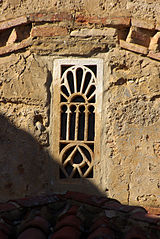Transenna

Transenna (Latin: lattice window, plural: transennes) is an ornamental openwork stone, wood or marble slab .
In Hellenistic and Imperial architecture, transenners were used as barriers. In pre-Romanesque architecture, they served as choir screens . Before the introduction of window glazing, they were used to close window openings. In Spanish, these window panels are also known as celosía (jealousy), the French equivalent of which is jalousie in the German term Jalousie . In Gothic architecture, the structure of windows and wall surfaces using stone profiles is called tracery .
Examples of the use of transenners as window panels can be found in the pre-Romanesque churches of the Iberian Peninsula , in Asturias , Galicia and Castile and León .
San Miguel de Villardeveyo Church in Llanera (Asturias)
San Miguel de Escalada Church in the Province of León
San Juan de Baños Church near Palencia
San Miguel de Lillo Church (Asturias)
San Salvador de Valdediós Church (Asturias)
See also
literature
- Hans Koepf , Günther Binding : Picture Dictionary of Architecture (= Kröner's pocket edition . Volume 194). 4th, revised edition. Kröner, Stuttgart 2005, ISBN 3-520-19404-X , p. 475.
- Nikolaus Pevsner , Hugh Honor, John Fleming: Lexicon of World Architecture . 3rd edition, Prestel-Verlag, Munich 1992, ISBN 3-7913-2095-5 , p. 639.




